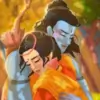Mythology isn't a historical timeline. It's storytelling. Storytellers reach for familiar stories, embellish them with allusions, and arrange cameo roles, flashbacks, and crossovers however they want to entertain the audience. There is a mutual understanding that mythical events are eternal: they happen every time they are narrated, depicted, performed, or meditated upon.
Inspired by this understanding, poets sometimes compose prayers in the present tense, as if divinities are falling in love, getting married, and nurturing babies right now.
When Janaka in Vālmīki's Rāmāyaṇa is showing Śiva's bow to Viśvāmitra, naturally, he talks of it being used to destroy Dakṣa's yajña, because the audience has heard of this exploit. And when Viśvāmitra is telling Gaṅgā's story to Rāma and Lakṣmaṇa, the devout audience would want him to mention that Himavat and Menā had a younger daughter who married Śiva and is the mother of Skanda. On the other hand, when the Śivapurāṇa storyteller has to explain the separation of Śiva and Satī, the parallel separation of Rāma and Sītā becomes an inspiration to bring them into the story.
The concept of four yugas in Hindu mythology is used to warn kṣatriya governors that they are responsible for the condition of society: they can motivate it to be perfect (Kṛta-yuga), or flourish (Tretā-yuga), or resist (Dvāpara-yuga), or perish (Kali-yuga).
In contrast, the idea that four yugas follow each other in a fixed pattern is comforting for non-kṣatriyas: society's problems will get better, and legendary times when heroes and deities walked the earth will come again.
To convey the vastness of Time, storytellers will say that the universe exists for a thousand catur-yuga cycles ... each Manvantara lasts for 71 catur-yugas ... Rāvaṇa lived through 13 catur-yuga cycles ... Rāmāyaṇa occurred in the 24th Tretā-yuga of Vaivasvata Manvantara and Mahābhārata occurred in the 28th Dvāpara-yuga ...
However, when storytellers want the past to have definite points of reference, they refer to yugas as if they happened only once.
Ancient audiences noticed the same anachronisms that we do today. Storytellers brought those concerns right into the text to address them, for example, when Janamejaya asks (Harivaṃśa 2.50-52): how could Dakṣa be born from Brahman's thumb and also be born to the Pracetas-brothers from Soma's daughter, and how could Dakṣa become the father-in-law of his own maternal grandfather Soma?
Vaiśaṃpāyana replies (Harivaṃśa 2.53-55):
utpattiś ca nirodhaś ca nityau bhūteṣu Bhārata
ṛṣayo'tra na muhyanti vidyā-vantaś ca ye janāḥ
Emergence and suppression are perpetual for living beings, descendant of Bharata! Sages are not confused by it, nor those people who are educated.
yuge yuge bhavanty ete sarve Dakṣ'ādayo nṛpa
punaś c'aiva nirudhyante vidvāṃs tatra na muhyati
In age after age, all of these exist, Dakṣa and so on, leader of men! And again they are suppressed, really. A wise person isn't confused by it.
jyaiṣṭhyaṃ kāniṣṭhyam apy eṣāṃ pūrvaṃ n'āsīj jan'ādhipa
tapa eva garīyo'bhūt prabhāvaś c'aiva kāraṇam
Seniority and juniority too formerly didn't exist for them, overlord of people! Only spiritual energy had more weight as a creator and as a cause.
However, this philosophical answer doesn't appeal to everyone. Some of us want all of the details to fit together in a neat chronology, even when they come from different storytellers with situational motives. That's why the authors of Purāṇas claimed that each text narrates what happened in a different kalpa or cosmic cycle.
In one version of the Satī-and-Dakṣa's-yajña myth, Satī goes to the yajña, confronts Dakṣa, and gives up her life there. In the Kālikāpurāṇa version, however, Satī never leaves Kailāsa; she gives up her life as soon as it registers that Dakṣa has insulted Śiva.
And in the Tamil movie Tiruviḷaiyāṭal (1965), Satī returns from Dakṣa's yajña to Kailāsa and Śiva kills her!
https://www.youtube.com/watch?v=AeIdBo1RDV4
While we're used to thinking that Śiva himself ... or his deputy avatāra Vīrabhadra ... or Vīrabhadra and Kālī together ... destroyed Dakṣa's yajña as soon as he lost Satī, I have even read that there's a version in which Satī is reborn as Pārvatī, she wins and marries Śiva, and only then they notice that Dakṣa's thousand-year yajña is still going on! In that version, the story has a happy ending with the God and Goddess reunited to destroy the yajña.
Edited by BrhannadaArmour - 1 years ago














 . I found each comment extremely interesting to read
. I found each comment extremely interesting to read .
. ...... just sharing across the table for all of you to ponder.
...... just sharing across the table for all of you to ponder.
























